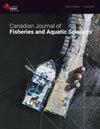Biologgers reveal unanticipated issues with descending angled walleye with barotrauma symptoms
IF 2.2
2区 农林科学
Q2 FISHERIES
Canadian Journal of Fisheries and Aquatic Sciences
Pub Date : 2024-01-10
DOI:10.1139/cjfas-2023-0141
引用次数: 0
Abstract
Canadian Journal of Fisheries and Aquatic Sciences, Ahead of Print.Without sufficient time to diffuse air from their swim bladders, physoclistous fish caught in deep water can exhibit symptoms of barotrauma. In this study, we tested the effectiveness of four barotrauma relief techniques on 76 walleye (Sander vitreus) and compared their 10 min post-release behaviour and depth selection with an untreated control group using a biologger containing a tri-axial accelerometer and depth sensor. Vented fish showed the best success rate of returning to depth, while no untreated controls were able to swim down. For fish that remained at depth, half were found to have lost orientation and were upside down during the entire monitoring period, with this orientation being strongly associated with the relief method. Vented fish had higher chances (80%) of remaining in the correct orientation at depth compared with the other methods (average of 38%). Our research shows that the best way to prevent negative outcomes of barotrauma is to avoid fishing at depths that yield barotrauma; however, if unavoidable, affected fish should be carefully vented by trained anglers to best reduce post-release impairments.
生物学家发现,有气压外伤症状的下降角度马口鱼会出现意想不到的问题
加拿大渔业和水产科学杂志》,提前印刷。 在深水中捕获的体表鱼类如果没有足够的时间扩散鳔中的空气,就会出现气压创伤症状。在这项研究中,我们测试了四种气压创伤缓解技术对 76 条马口鱼(Sander vitreus)的有效性,并使用包含三轴加速度计和深度传感器的生物传感器比较了它们在释放后 10 分钟的行为和深度选择与未处理的对照组。排气鱼返回深度的成功率最高,而未经处理的对照组则无法下潜。对于留在深海的鱼类,发现有一半失去了方向感,在整个监测期间都是倒立的,这种方向感与浮力法密切相关。与其他方法(平均 38%)相比,通风鱼在深度保持正确方向的几率更高(80%)。我们的研究表明,预防气压创伤负面结果的最佳方法是避免在会产生气压创伤的深度钓鱼;但是,如果不可避免,应由训练有素的钓鱼者对受影响的鱼进行仔细排气,以最好地减少释放后的损伤。
本文章由计算机程序翻译,如有差异,请以英文原文为准。
求助全文
约1分钟内获得全文
求助全文
来源期刊

Canadian Journal of Fisheries and Aquatic Sciences
农林科学-海洋与淡水生物学
CiteScore
4.60
自引率
12.50%
发文量
148
审稿时长
6-16 weeks
期刊介绍:
The Canadian Journal of Fisheries and Aquatic Sciences is the primary publishing vehicle for the multidisciplinary field of aquatic sciences. It publishes perspectives (syntheses, critiques, and re-evaluations), discussions (comments and replies), articles, and rapid communications, relating to current research on -omics, cells, organisms, populations, ecosystems, or processes that affect aquatic systems. The journal seeks to amplify, modify, question, or redirect accumulated knowledge in the field of fisheries and aquatic science.
 求助内容:
求助内容: 应助结果提醒方式:
应助结果提醒方式:


